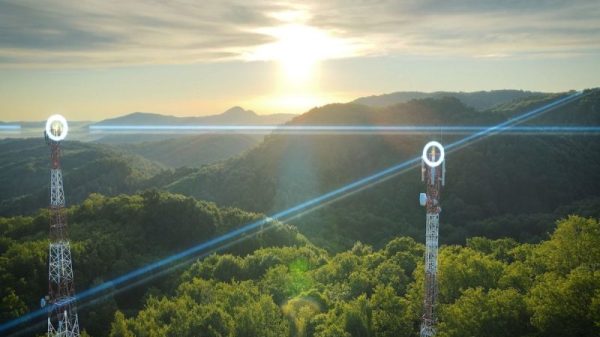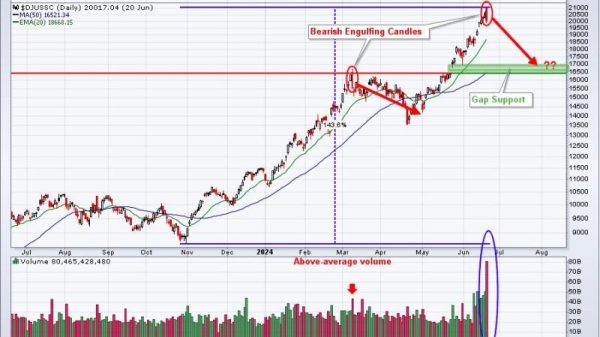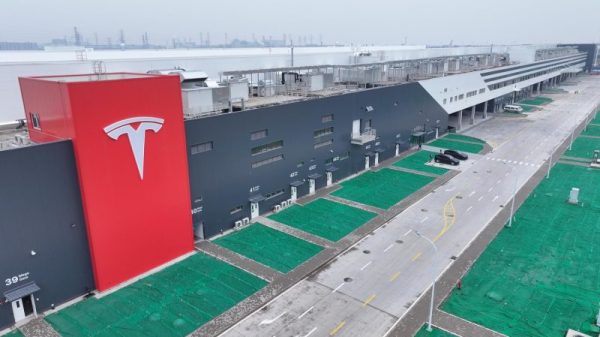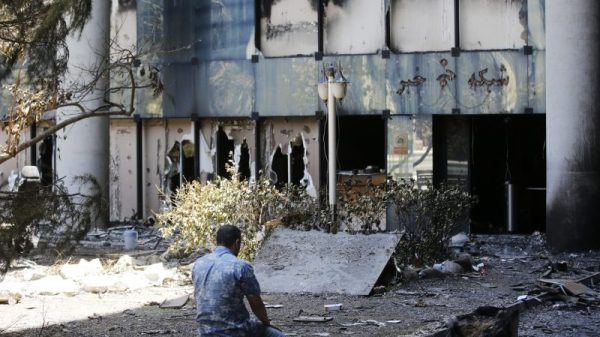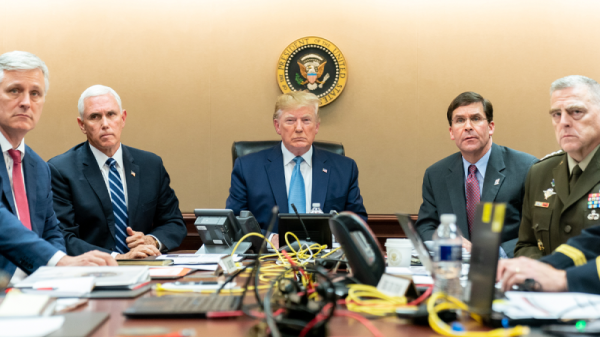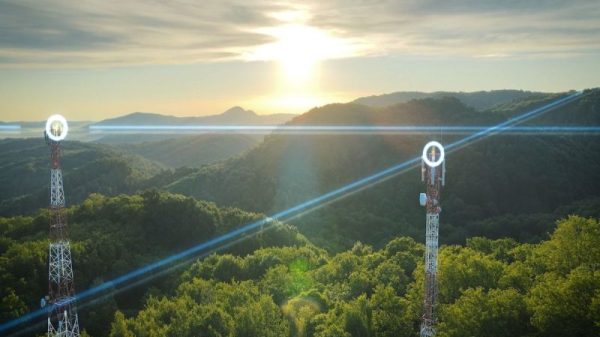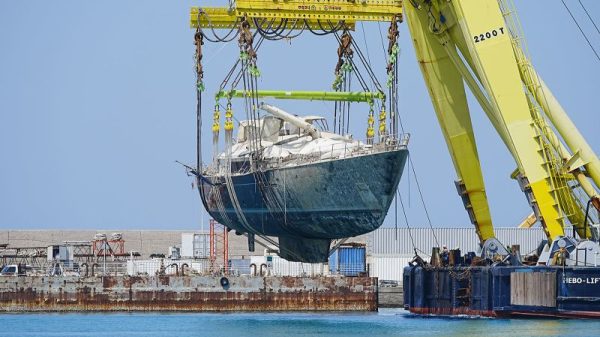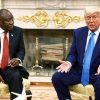As dawn slowly broke on the horizon, a large fleet of Chinese vessels came into view from the deck of a Philippine Coast Guard ship as it entered the contested waters of the South China Sea.
Significantly outnumbered by the number of Chinese vessels, the four ships in the Philippine convoy on a resupply mission to troops were quickly surrounded and separated during a frantic high seas skirmish on Tuesday morning.
Within just a few hours, the window of one Philippine boat would be shattered by water cannon and four sailors aboard would be injured.
China’s determination to assert its disputed sovereignty over the entirety of the vast South China Sea has sparked increasing clashes with its neighbors in recent years, particularly the Philippines, which is a mutual defense ally of the United States.
The Philippine ship tried to find safe passage through myriad China Coast Guard ships as well as fishing vessels that form part of China’s shadowy “maritime militia” blocking their path.
The Philippines accused the China Coast Guard ships of colliding with two of their vessels, causing damage to their exteriors. One of the smaller Philippine boats was also hit by water cannons from two Chinese vessels, shattering the windshield and leaving the crew on board with injuries.
China countered that its coast guard vessels “took control measures” against Philippine ships that it claimed “illegally intruded” into its sovereign territory. It said the damaged Philippine ship ignored repeated warnings and “deliberately rammed” into a China Coast Guard vessel in what it said was an “unprofessional and dangerous manner.”
Resupply for a crumbling wreck
Their mission was to resupply a small group of marines living on a World War II-era ship grounded on an obscure contested reef.
Missions like this have become one of the most regular causes of direct confrontations between the Philippines and its giant neighbor China, which has built up the world’s largest navy. What happens among the tiny islands, reefs and atolls of this corner of the globe could have profound international repercussions and become a major global flashpoint.
Departing the sleepy port of Bulilyan on the southern tip of the Philippines’ Palawan Island, two Philippine Coast Guard ships embarked on a 13-hour overnight journey north to the Sabina Shoal, where they met up with two smaller resupply vessels staffed by the Armed Forces of the Philippines, transporting food, water and other essentials.
The coast guard ships then tried to escort the smaller vessels as they navigated the disputed waters on a four-hour steam toward the next location.
Their target was the Sierra Madre, a rusted ship that rests on a strategically vital shoal that has become the epicenter of this simmering confrontation.
The US-built Philippine Navy landing craft was run aground deliberately in 1999, with a national flag hoisted on board. Since then, rotating detachments of Filipino marines have been living on board, hunkering down through tropical heat, typhoons and long spells away from home in a bid to assert territorial rights and prevent any Chinese development there.
The vessel rests atop a contested reef, which even has a name that is under dispute. Though internationally known as the Second Thomas Shoal, the Philippines call the reef Ayungin Shoal, and China refers to it as Ren’ai Jiao.
The teardrop-shaped reef forms part of the contested Spratly islands – which are all claimed by China. The Philippines, Vietnam, Malaysia, Brunei and Taiwan have also made territorial claims to some of the shoals.
During the confrontation, Filipino crews counted a total of five China Coast Guard vessels, 18 boats belonging to Beijing’s “maritime militia” – and at a further distance, two Chinese naval vessels and a military helicopter, said Coast Guard spokesperson Commodore Jay Tarriela on Wednesday.
“The Philippines is solely responsible for this,” China’s Coast Guard said. “The Philippines is dishonest in its statements, deliberately stirs up trouble, maliciously incites and sensationalizes, and continues to undermine peace and stability in the South China Sea region.”
China’s Foreign Ministry has lodged a solemn representation with the Philippines to extend its “strongest protest,” spokesperson Mao Ning said in a regular press briefing Tuesday.
In December, a Chinese Foreign Ministry spokesperson accused the Philippines of making repeated provocations and infringing on China’s sovereignty. Earlier in 2023, China also accused the Philippines of attempting to deliver “construction materials” to reinforce the Sierra Madre, which meant “the Chinese side was made to respond with necessary moves” adding that the China Coast Guard “took warning law enforcement measures.”
Fighting over reefs and atolls
At first glance it’s hard to imagine why these remote, unpopulated reefs and atolls are so hotly contested – but they lie in a strategic location in Asia’s main shipping lane, which has more than $3.4 trillion in trade passing through it every year, according to the Center for Strategic and International Studies’ (CSIS) China Power Project.
Over the last few decades, China has built up tiny reefs and sandbars far from its shores across the waterway into artificial islands heavily fortified with missiles, runways and weapons systems – sparking outcry from the other claimants.
The Philippines says the development of Mischief Reef, close to Second Thomas Shoal, was what originally prompted them to ground the Sierra Madre.
In 2016, in a case brought by the Philippines, an international tribunal in the Hague ruled that China’s claim to historic rights to the bulk of the sea had no legal basis.
But Beijing has rejected the tribunal’s ruling and continued its military buildup, with many features lying hundreds of miles away from China’s mainland. It also maintains a large presence of coast guard and fishing vessels – which has frequently stoked tensions with its neighbors.
China’s Foreign Ministry has long defended the behavior of its vessels in the South China Sea and said Beijing will “firmly safeguard” what it views as its territorial sovereignty. It insists that the Philippines is illegally occupying the Second Thomas Shoal.
The US military also maintains a regular presence in the South China Sea, with aircraft overflights, so-called “freedom of navigation” operations, and patrols and exercises with allies and partners to assert that the South China Sea is an international waterway.
Since his election in 2021, Philippines President Ferdinand “Bongbong” Marcos Jr., has taken a stronger line against China, in a departure from the foreign policy approach of his predecessor Rodrigo Duterte, who trod much more softly with Beijing in return for economic cooperation.
Last week, Marcos Jr. told Australian lawmakers that his country is on the “front line” of maritime disputes and “will not yield” an inch of territory.
The Philippines ambassador to the US, Jose Manuel Romualdez, also said last week that the South China Sea – not Taiwan – is the “real flashpoint” for an armed conflict in the region, and warned that “all hell breaks loose” if Washington decides to invoke its mutual defense treaty to protect Manila, according to the state-run Philippine News Agency.
Diplomacy has taken place between the two sides, with a bilateral meeting held in Shanghai between China and the Philippines late January and both sides agreeing to calm tensions and find ways to communicate over their differences.
But the reality out at sea is quite different.
Rats and roaches
For the Filipinos who conduct this resupply mission every month, the maritime confrontations with China have become routine.
The missions are exhausting and dangerous, and often carried out in sweltering temperatures, but there’s a sense of pride among the crew, who believe they are trying to protect their nation’s territory. They call themselves “Coast Guardians.”
Tarriela, the Coast Guard spokesperson, said a China Coast Guard vessel had come within 20 yards (60 feet) of the Cabra.
The women and the officers on board stay in bunk rooms, and the rest of the crew sleep in a communal room below deck, which also doubles up as the dining hall – unfortunately making it a favorite spot for cockroaches.
But the living conditions on the coast guard vessel are still far better than on the wreck of the Sierra Madre.
They caught their own fish and cooked them on board for most of their meals, and they tried to create a makeshift gym using random items on the deck as weights.
To make their time a little easier, care packages are sometimes airdropped into the ocean – in 2014, that included letters of support from schoolchildren, and fried chicken from the Philippine fast food institution Jollibee.
The marines, who usually carry out a 90-day deployment on the ship, are sometimes rotated out during the resupply missions at sea – with a successful rotation carried out on Tuesday, said Tarriela.
During the mission, only one of the two resupply boats successfully made it to the Sierra Madre due to the Chinese maritime blockade, reducing their supplies until next month’s attempted mission – which will likely face the same confrontations with China. Still, the fact that they managed to deliver supplies at all made the trip “a success,” Tarriela said.
A US warship, the USS Mobile, was spotted on the Philippine crews’ journey out on Monday evening, ahead of the confrontation with Beijing, said Tarriela. However, he said, the Philippines did not coordinate with the US during the operation.
After the clash on Tuesday, the US released a statement saying it “stands with our ally the Philippines following (China’s) provocative actions against lawful Philippine maritime operations in the South China Sea on March 5.”
It also pointed to its mutual defense treaty with the Philippines, which it said “extends to armed attacks on Philippine armed forces, public vessels, or aircraft – including those of its Coast Guard – anywhere in the South China Sea.”
‘Gray zone’ tactics
Analysts say China employs “gray zone” tactics around Second Thomas shoal, carrying out actions just below what might be considered acts of war but that achieve the same result: Beijing gaining territory or control without firing a shot.
But Collin Koh, research fellow at the S. Rajaratnam School of International Studies in Singapore, said it may be time for the US to reevaluate what constitutes an act of war after watching the video of the water cannon smashing the Philippine vessel’s windows.
“Without clarifying what ‘armed attack’ constitutes, this episode will keep recurring since Beijing senses impunity,” Koh said.
Ray Powell, director of SeaLight at the Gordian Knot Center for National Security Innovation at Stanford University, said the onus is on Philippine partners and allies, like the US, to take new actions to push back on China.
“Will the US, its allies, other members of the international community, will they get together and say something more than finger-wagging has to happen here?” Powell said.
“Because we’ve tried that, and it doesn’t seem to be discouraging or deterring China at all.”




